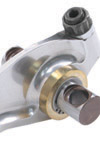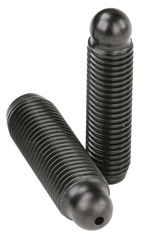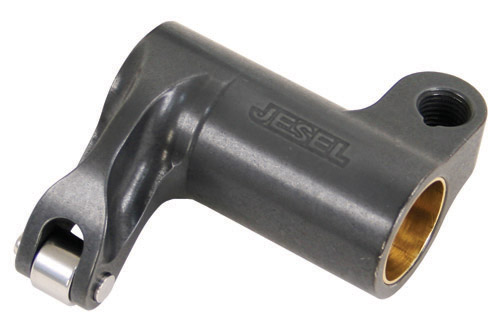In a nutshell
 Despite the general movement of production engines toward smaller displacement, overhead-cam designs, single-cam-in-block-pushrod-rocker arm V8 engines are firmly rooted in several popular segments of the stateside motor sports world (NASCAR Cup, Truck, NHRA Top Fuel, Funny Car, etc.). In these (and other) areas of extreme racing, the engineering challenges to make a pushrod-rocker valve system operate reliably above 8000 rpm are severe. To make a pushrod valvetrain work at all at 10,000 rpm for five seconds is daunting; to make one work at 9000+ rpm for three hours is thought by some to be unbelievable. Yet the evidence is at the tracks nearly every weekend.
Despite the general movement of production engines toward smaller displacement, overhead-cam designs, single-cam-in-block-pushrod-rocker arm V8 engines are firmly rooted in several popular segments of the stateside motor sports world (NASCAR Cup, Truck, NHRA Top Fuel, Funny Car, etc.). In these (and other) areas of extreme racing, the engineering challenges to make a pushrod-rocker valve system operate reliably above 8000 rpm are severe. To make a pushrod valvetrain work at all at 10,000 rpm for five seconds is daunting; to make one work at 9000+ rpm for three hours is thought by some to be unbelievable. Yet the evidence is at the tracks nearly every weekend.
The following is a bite-sized synopsis of a few of those engineering challenges.Sources of loads experienced in a pushrod-rocker system:

Spring-related
Whenever a rocker arm is holding a valve off its seat, that rocker arm experiences contact, bending (tensile and compressive), and shear stresses as a result of valve spring loads. Pushrods must bear compression, contact, shear, and even bending (resulting from column-deformation) stresses. The compressive load applied to the tip of the pushrod is the instantaneous spring force multiplied by the instantaneous rocker ratio. (Note that spring forces on the rocker and pushrod go to zero during lofting.
Acceleration-related
In an effort to maximize the area under the valve lift versus rotation curve, race cam lobes incorporate the highest levels of acceleration (increasing the velocity away from the seat and decreasing the velocity moving toward the seat) the lobe designer thinks the valvetrain will survive. The acceleration and jerk (impact) forces applied to the rocker and pushrod as a result of the opening and closing ramps of the cam lobes increase with the square of rpm. Those loads apply the same types of stresses to the rocker and pushrod as do the valve springs, but at much higher levels. Spring loads prevail (over the nose) at lower speeds. Acceleration and jerk forces prevail at higher rpm, and the over-the-nose load the springs apply to the rocker and pushrod approach zero as rpm increases. It is also interesting to note that these acceleration forces are transmitted across the rocker arm to the tip of the pushrod at the square of the rocker ratio.

Impact
A poorly designed or manufactured cam lobe can have high rates of change of acceleration (jerk) which imparts impact loads to the entire valvetrain. Valve lofting causes impact loads on the entire valvetrain when the separated valvetrain components reconnect. (I know of one particular helicopter engine in which the cam lobe acceleration curves rise nicely then go flat to a constant acceleration value, then suddenly ramp downward toward zero on both the opening and closing side. The resulting jerk forces typically destroy the valvetrain in about 200 hours of operation at 4200 rpm.)

Vibration
Intermittent forces applied to a mechanical system at a regular interval (excitation) will cause components to vibrate in any number of ways if the excitation or a harmonic of the excitation is close to a natural frequency of a given component. The acceleration profile of an aggressive cam lobe can contain several high-amplitude harmonics, any of which could coincide with a component’s natural frequency. It is important to try and design valvetrain components (pushrod, rocker and springs especially) so that their natural frequencies are as far away from high excitation harmonics as possible. That is often much easier said than done, especially in engines having a wide operating band. (Cup engines at Martinsville go from about 5500 to 9300 rpm twice per lap.)

Cylinder pressure acting on the valve area
For a NASCAR Cup engine at full tilt, Professor Blair noted that the cylinder pressure early in exhaust valve opening (EVO) is sufficient to keep the valve seated for 8-10 cam degrees while the pushrod-rocker valvetrain flexes to accommodate the motion imparted by the cam ramp. That situation is even worse in a blown nitromethane NHRA motor, which retained so much cylinder pressure at EVO that exhaust pushrods can be bent, and until the advent of some recent technology, the use of roller-tipped exhaust rockers was often avoided.
Friction in the rocker bearings and rocker-valve interface
For the sake of completeness, friction needs to be considered. In a non-roller-tip rocker arm, the friction at the valve stem interface can be high, and the resulting lateral forces applied to the valve can generate some rapid valve guide wear. In some cases, friction can be beneficial in that it can apply damping forces to various components in the system and thereby help to control the amplitude of vibrations being driven by an excitation frequency in the vicinity of resonance.